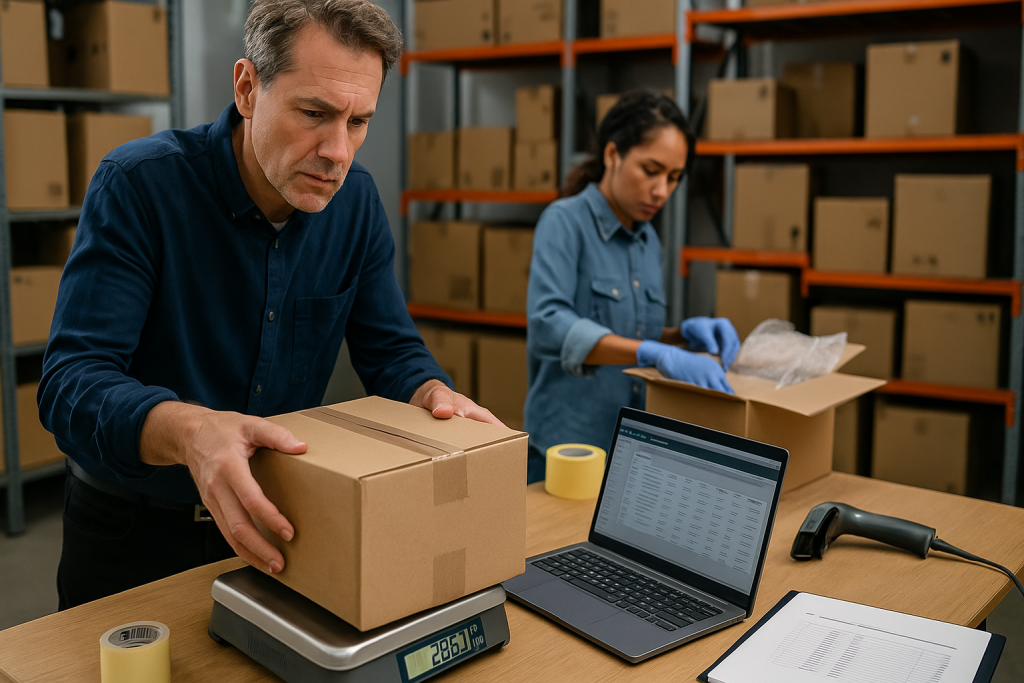By Martin Vassilev / 5 Nov, 2025
E-commerce is thriving — but so are hidden inefficiencies. Many brands lose as much as 20–40% of their profit margins due to fulfillment errors that compound over time. Poor logistics execution, inaccurate inventory tracking, and inefficient warehouse management silently eat away at your bottom line. In a competitive market where customers expect fast, affordable delivery, fulfillment isn’t just an operational function — it’s a strategic advantage.
This guide exposes the most costly fulfillment mistakes and actionable ways to fix them — helping your brand cut waste, improve customer satisfaction, and restore healthy profit margins.
Before diagnosing fulfillment issues, it’s essential to grasp how fulfillment impacts profitability. Every order that leaves your warehouse carries multiple cost layers — storage, packaging, labor, carrier fees, returns, and technology. When these systems lack synchronization, inefficiencies multiply.
According to a report by the U.S. Small Business Administration (SBA.gov), fulfillment costs can exceed 25% of total operating expenses for e-commerce businesses. Streamlining these processes through optimized warehousing and logistics not only saves money but also improves customer experience — the twin drivers of e-commerce growth.
For a deeper understanding of fulfillment operations, see What Is a Fulfillment Center and How Does It Work? by ByExpress.
A disorganized warehouse can reduce picking productivity by up to 50%, according to Material Handling Institute (MHI). Poorly designed storage layouts increase travel time, cause mis-picks, and create bottlenecks during high-volume periods.
Use data analytics to track order patterns and reconfigure product placement.
Implement ABC inventory classification (high-demand items closest to packing stations).
Leverage automation to improve throughput — a concept detailed in The Future of Warehouse Automation.
A strategic warehouse layout ensures workers move efficiently, minimizing errors and boosting order accuracy.
Inventory mismanagement is one of the biggest killers of profit margins. Overstocks lead to tied-up capital, while stockouts trigger lost sales and customer dissatisfaction. According to Harvard Business Review, poor inventory accuracy can lead to 8–10% revenue loss annually.
Integrate real-time tracking systems like RFID or barcode scanning.
Sync all channels with a centralized inventory management system.
Use predictive analytics — learn more at How to Leverage Data Analytics for Streamlined Inventory Management.
Automation minimizes human error, ensuring data-driven decisions rather than guesswork.
Many e-commerce companies underestimate how packaging directly affects profitability. Oversized or poorly chosen packaging inflates dimensional shipping costs and wastes materials. Moreover, improper packaging causes damage — leading to returns and replacements.
Adopt right-sized packaging algorithms to minimize wasted space.
Source eco-friendly materials to reduce weight and qualify for green logistics incentives (see EPA.gov for sustainability guidelines).
Train staff on consistent packing standards to reduce human variability.
Packaging is both a cost and a branding tool — when optimized, it improves efficiency and customer perception simultaneously.

Last-mile delivery often accounts for more than 50% of total shipping expenses. Unoptimized routes, poor carrier negotiations, or lack of local delivery options dramatically reduce profitability.
Use regional distribution centers to shorten delivery distances.
Partner with reliable local 3PL providers such as ByExpress Ottawa Fulfillment Services.
Implement dynamic route optimization software to minimize fuel costs.
Offer consolidated delivery options to balance speed and cost.
Leveraging data-driven route management and strategic location planning can transform last-mile delivery from a cost burden to a competitive advantage.
Studies show over 30% of online purchases are returned — and mishandling them can turn a manageable process into a profit killer. Poorly managed returns lead to restocking delays, damaged inventory, and wasted labor hours.
Establish a clear, automated return system using integrations like Returns Management Solutions.
Inspect and restock quickly to minimize dead inventory.
Offer exchanges instead of refunds to preserve revenue.
Reverse logistics, when optimized, can even improve customer loyalty and drive repeat purchases.
When warehouse management, e-commerce platforms, and shipping carriers don’t communicate, you risk duplicate data, delayed orders, and frustrated customers. Manual data entry creates errors that quickly multiply at scale.
Deploy API integrations for seamless communication between order management and logistics systems (Custom API Integrations).
Choose fulfillment partners offering real-time visibility and data synchronization.
Utilize AI-powered forecasting tools, as covered in How AI Is Transforming the Logistics Industry in 2025.
Unified technology not only improves operational speed but also creates transparency for customers and management alike.
Many e-commerce businesses fail to plan for seasonal demand spikes, leading to overworked staff, delayed orders, and storage shortages. The lack of flexible capacity damages customer trust and profit margins.
Use on-demand warehousing to scale temporarily during peak seasons.
Study patterns from Canadian 3PL Seasonal Demand to anticipate future surges.
Collaborate with flexible fulfillment networks that can reallocate resources rapidly.
Agility is the backbone of sustainable e-commerce fulfillment — flexibility wins in high-demand markets.
Without metrics like Order Accuracy Rate, Pick Efficiency, or Cost per Order, it’s impossible to optimize fulfillment. Many companies operate on intuition rather than measurable performance data.
Track warehouse KPIs — explore Top Warehouse KPIs Every Supply Chain Manager Should Track.
Conduct monthly audits to identify bottlenecks.
Use dashboards for real-time visibility on key logistics parameters.
Data visibility transforms fulfillment from a cost center into a strategic profit engine.
Outsourcing doesn’t automatically guarantee efficiency. Many e-commerce brands lose margins by partnering with fulfillment centers that lack scalability, transparency, or modern technology.
Vet 3PL providers thoroughly — read the Guide to Choosing the Right Fulfillment Partner.
Request transparent cost breakdowns.
Prioritize providers that integrate AI, automation, and data analytics into operations.
Working with a reliable fulfillment company like ByExpress ensures optimized operations, scalability, and customer satisfaction.
Sustainability is more than an ethical choice — it’s a financial one. Consumers increasingly prefer eco-conscious brands, and inefficient logistics waste both energy and resources.
Transition to electric or hybrid delivery fleets.
Use biodegradable packaging and energy-efficient warehouses.
Learn from The Role of Green Logistics in Modern Warehousing.
By aligning with sustainable practices, you improve brand loyalty and reduce long-term operational costs.
Every inefficiency — from inventory errors to poor packaging — increases operational costs, lowering profit margins. Optimized fulfillment directly impacts customer satisfaction and retention.
Manual inventory management and lack of system integration are the biggest culprits, leading to order delays and stock inaccuracies.
Automation enhances speed, accuracy, and scalability. AI-driven analytics help forecast demand and streamline warehouse operations.
Yes, if they choose the right partner. Partnering with a trusted provider like ByExpress ensures access to advanced technology and scalable warehousing.
Add storage, labor, packaging, and shipping costs, then divide by the total orders fulfilled. Tracking this regularly reveals cost trends and improvement opportunities.
E-commerce fulfillment isn’t just about shipping boxes — it’s about building an ecosystem that maximizes efficiency, accuracy, and customer trust. By addressing the fulfillment mistakes outlined here, brands can reclaim lost profits, strengthen operations, and scale sustainably.
If you’re ready to identify and fix the gaps in your logistics system, explore The Ultimate Guide to Efficient Warehousing or connect directly through our Contact Page.

“Thanks to Byexpress all my shipping and fulfillment costs are in line now”

“All my issues were solved by Byexpress team that I had with pervious 3pl provider.”

“Thank you Byexpress team could not done it without you guys.”

“Their integration and customer service were the key for me”

“Outstanding delivery service! The package was well-packaged, and
the delivery team was professional and courteous”

“Great and knowledgeable team to work with.”

Thanks, guys, for reducing my shipping rates
Ottawa Office
2411 Holly Lane
Ottawa, ON, K1V 7P2
Toronto Office
13-280 West Beaver Creek Road Unit #136
Richmond Hill, ON, L4B 3Z1
Alexandria Office
173 Kenyon Street West
Alexandria, ON, K0C 1A0
Montreal Office
4388 Saint-Denis Street Unit #200
Montreal, QC, H2J 2L1
California Office
155 North Riverview Drive
Anaheim Hills, CA, 92808
Call Us
Toll-Free: 1-866-744-7122
Local : 613-739-3000
Email Us
Multilingual Services










